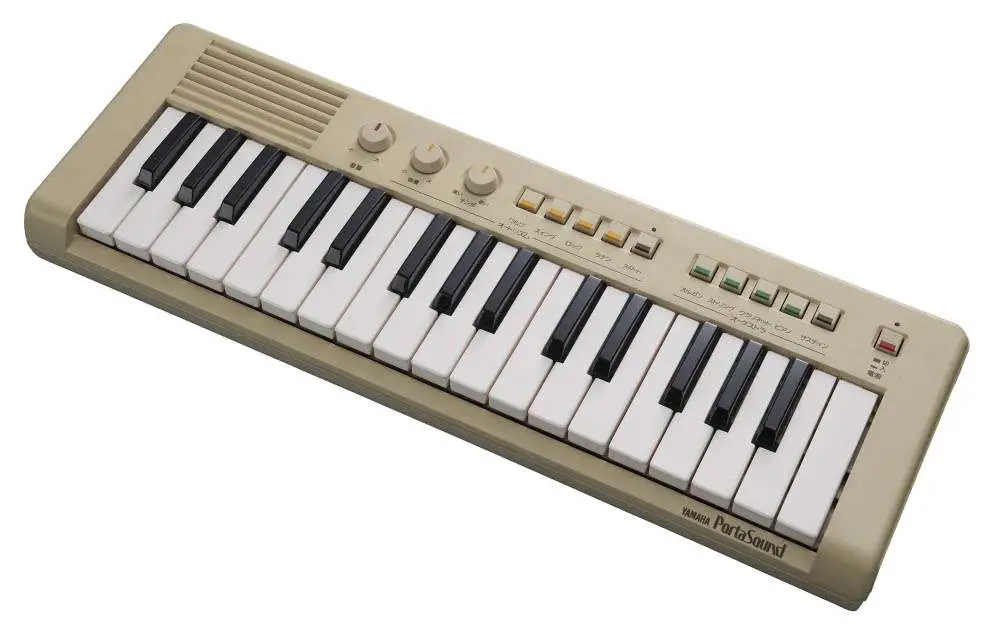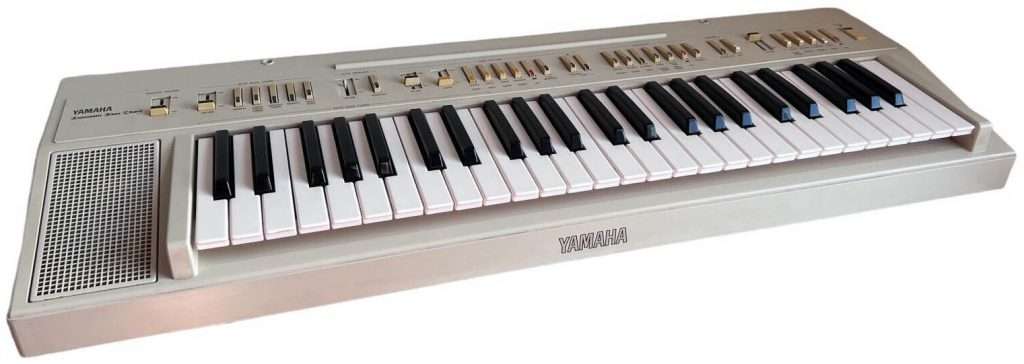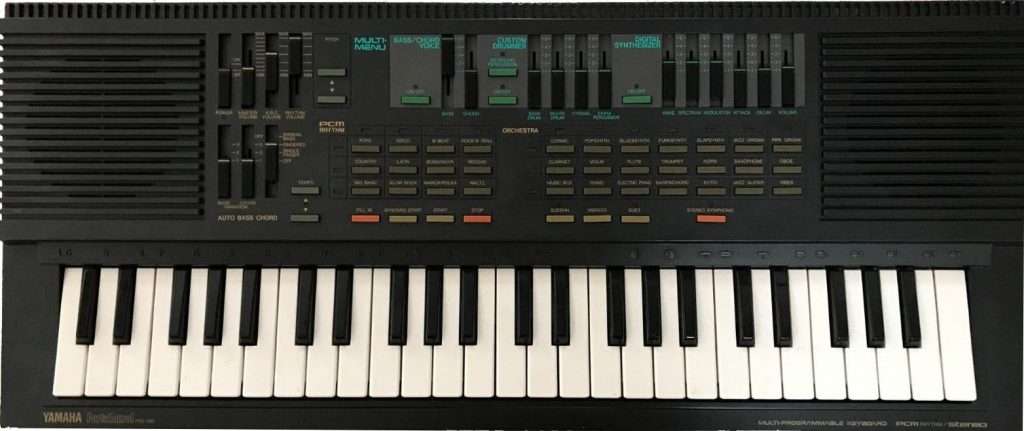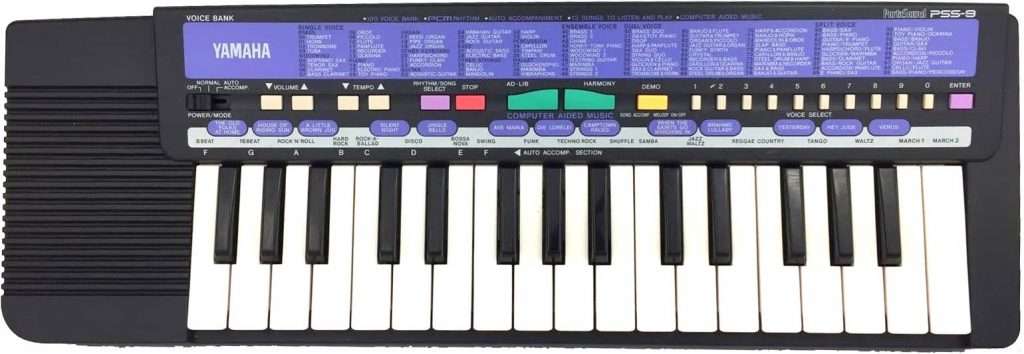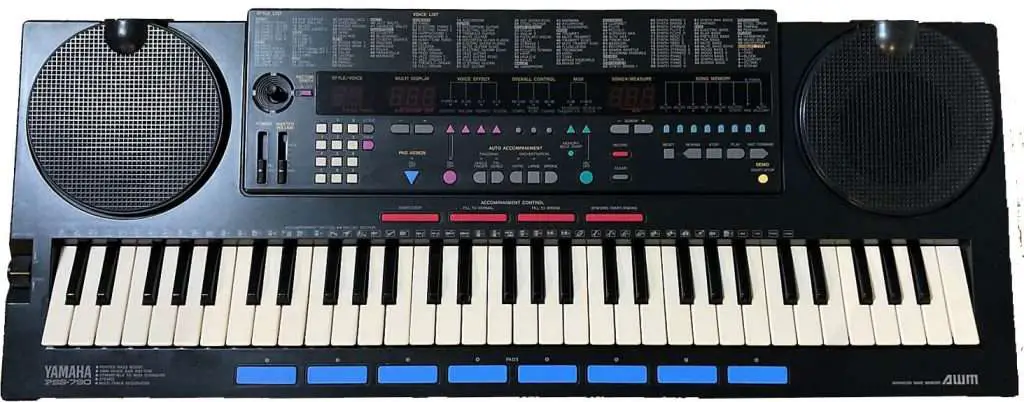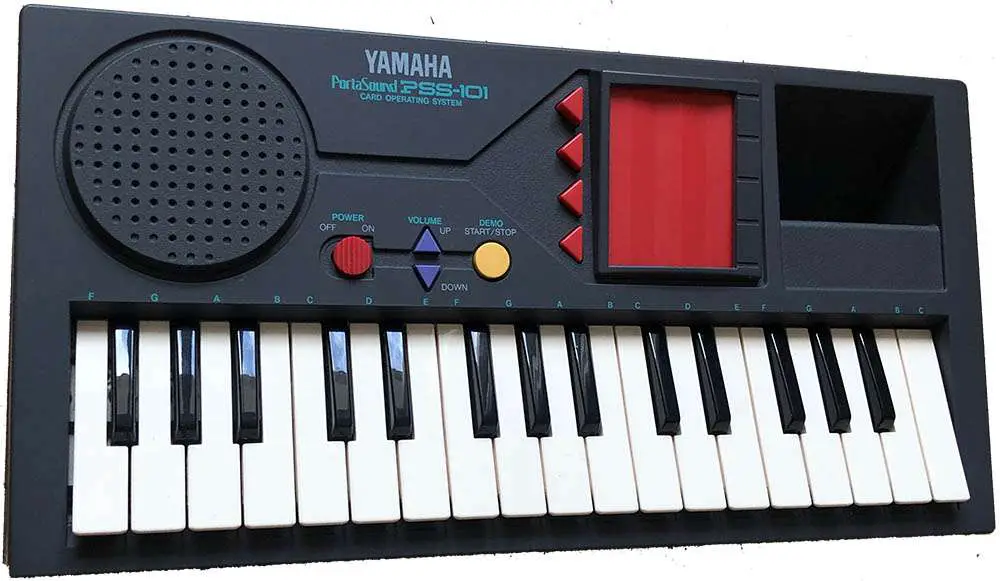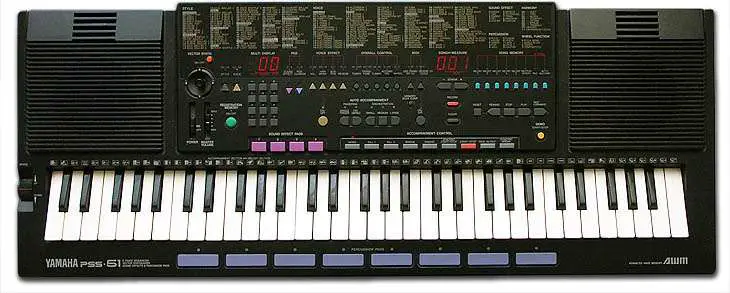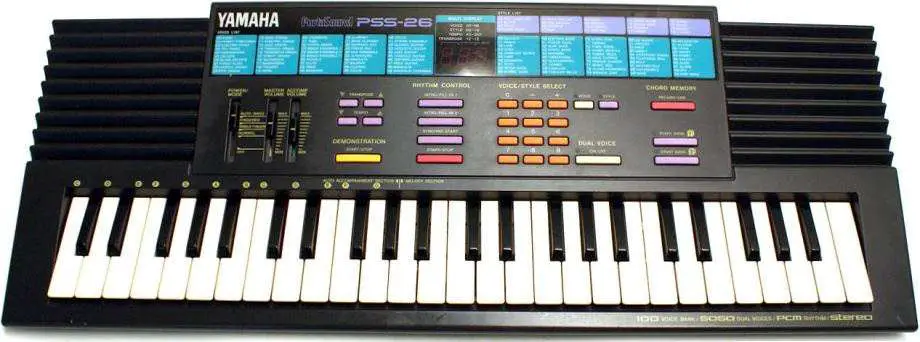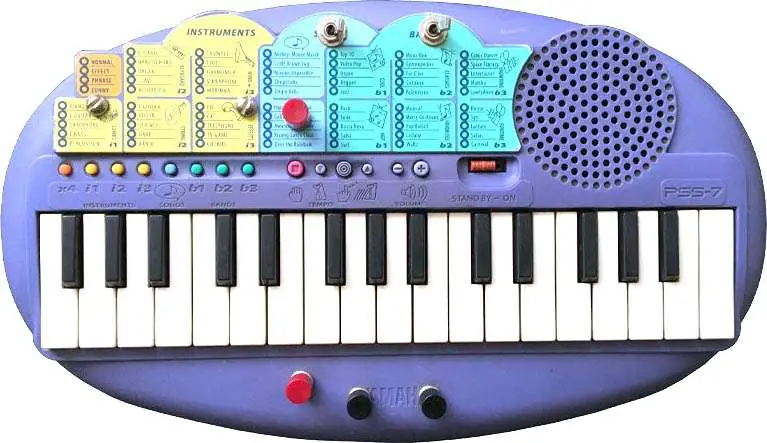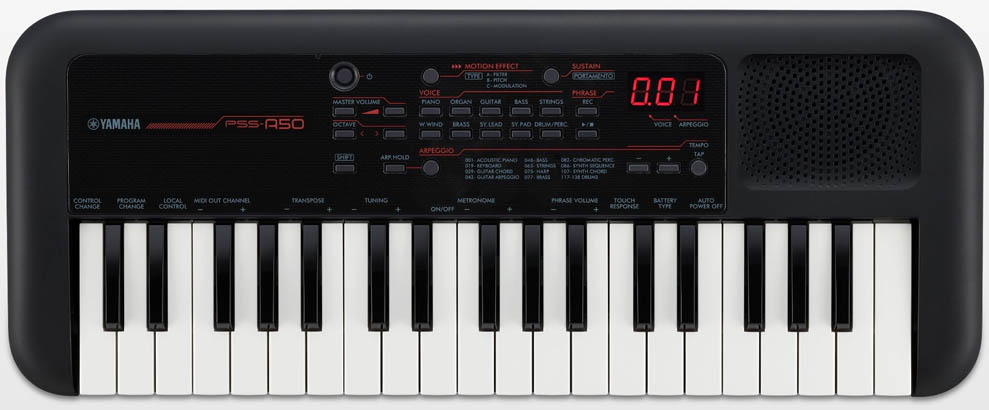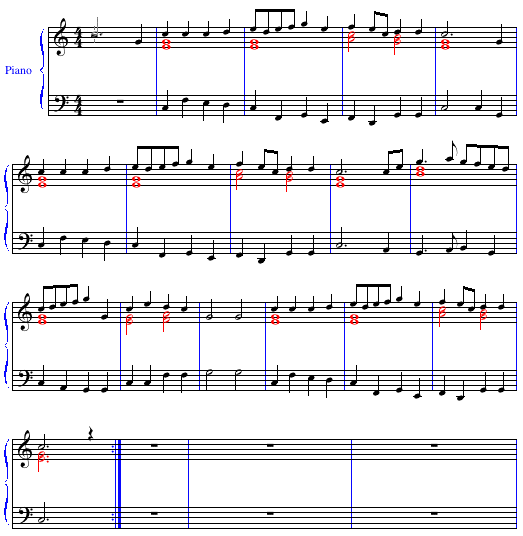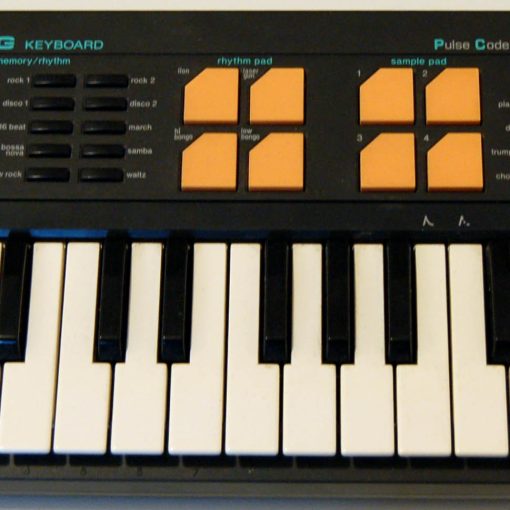For the best part of two decades, in the 1980s and 1990s, Yamaha created some iconic mini music keyboards under the PortaSound name. Many of these were simple instruments aimed at children and/or beginners, but as the years rolled on, a number of additional features were added. Even today, some PortaSound (PSS) models are desirable as authentic “lo-fi” sound generators for many composers and music producers. There have been close to 80 models with the PS, PSS or PortaSound branding.
Various models used a range of sound generation technology including playing samples, FM synthesis and wavetables. None used the AWM technology to be found on later PSR PortaTone keyboards.
A number of the PSS models used the YM3812 sound chip, capable of FM synthesis, including the PSS-360, PSS-460, PSS-470, PSS-560 and PSS-570. A scaled down chip, the YM2413, was used in the PSS-140, PSS-170 and PSS-270. A YM3301 chip was also added to some models to handle percussion sounds.
Yamaha PortaSound keyboards were designed for both home and educational use, being compact and lightweight for easy carrying, and featuring simple and user-friendly interfaces, making them accessible to musicians of all skill levels.
Some of the Yamaha PortaSound models had built-in speakers, making them ideal for playing music on the go or in small spaces. They also came with a variety of voices and accompaniments, as well as the ability to record and play back performances.
Overall, Yamaha PortaSound keyboards were popular for their affordability, versatility, and portability, making them a popular choice for aspiring musicians and music enthusiasts. While these keyboards may not have had the same level of sound quality and features as Yamaha’s higher-end models, they still offer a great introduction to the world of electronic music.
We’ve tried our best to be as thorough as possible, but with some models now long extinct, and the diminishing availability of accurate information and resources for electronic equipment from the 1980s and 1990s, we can’t automatically cover everything in great detail. We will continue to add to this page as more data becomes available. We’ll also link to other pages, both on this site and elsewhere, when good archive/comparison information and resources are available.
PS Models
Yamaha’s first PortaSound branded keyboards had the PS prefix on model numbers, and began with a trio in 1980: the PS-1, PS-2 and PS-3. These are billed as analog instruments using filtered square waves to generate their sounds.
The PS-1 is the entry model and has four rhythm sounds and four tones, and a decent 8 notes of polyphony. The PS-2 has five sounds and the PS-3 has nine.
Available in delightful beige colouring and coming with their own carry cases, these were reasonabluy capable instruments for the time, and in fact were more advanced than the first early ’80s PSS branded instruments (see further down this article).
The PS-1 has 32 mini keys, the PS-2 37 and the PS-3 44. This makes the PS-3 quite a capable little machine for its time.
In 1981 Yamaha launched three more PS models: the PS-10, PS-20 and PS-30. All came with 49 keys, 8 or 10 note polyphony and an increased number of rhythms and sounds. Unusually for the PortaSound range, they had full-size keys rather than the mini ones we tend to associate with the class.
The instruments also introduced features such as auto-accompaniment chords and connections for audio and pedals, although the PS-10 seemed to be a very cut down model whereas the PS-20 and PS-30 were more advanced. A rare black model, the PS-30B, was also released.
In 1982, the PS-300 and PS-400 were launched, along with the unique MP-1 which was branded as PortaSound.
The PS-300, still in beige, featured 37 keys, 8 sounds, 10 rhythms, while the PS-400, in black casing, had 44 keys, 10 sounds and rhythms.
1983 saw a flurry of PortaSounds including the PS-25, PS-35, PS-35S (stereo speakers), PS-55, PS-55S (stereo speakers) and MK-100. The PS-25, PS-35 and PS-55 had 49 full size keys and increasing numbers of sounds and rhythms.
The MK-100 was an interesting early attempt at giving the user some control over the sounds and programming of the instrument, usually reserved for those willing to toy with proper synths, and included a multi menu offering such goodies as a waveform synthesiser, envelope synthesiser, melody mixer, chord and bass voice variation, custom drummer and bassist, a music programmer, and a tape interface. Remember this was in the early ’80s when you’d only expect to find this kind of functionality on synths or beasts such as the DX7 (which also came out in ’83).
We round out the PS PortaSounds in 1984 with the PS-200 and PS-6100.
Early PSS Models
Concurrently with the PS models came Yamaha’s PSS keyboards. The first model Yamaha released in its PSS range was the PSS-30 in 1982.
In 1985 came the PSS-110, PSS-150, PSS-260, PSS-450 and PSS-401. These were still fairly basic instruments.
The PSS-401 was a 44-key edition of the PS-300, having additional octave control but a reduced rhythm section.
These instruments were now firmly in the digital realm. Most were using some form of YM chip, including the YM2413 and YM3812.
In 1986 came the PSS-120, PSS-160, PSS-170, PSS-360, PSS-460 and PSS-560.
The PSS170 had 44 keys and 100 sounds. The PSS-270 featured two FM synthesis operators and nine voice polyphony. The PSS-360 featured square wave synthesis, while the PSS-560 had an additional drum chip on board.
In 1987 came the PSS-130, PSS-370, PSS-470 and PSS-570.
The PSS-570 also had the additional drum chip on board.
In 1988 came the PSS-8, PSS-140, PSS-480 and PSS-680.
The PSS-680 included drum pads and a MIDI interface.
In 1989 came the PSS-20, PSS-80, PSS-80R, PSS-100, PSS-280, PSS-380, PSS-580 and PSS-780.
By this stage, several of the PortaSound keyboards were gaining MIDI capability, meaning they could be hooked up to other instruments or a computer with a suitable interface in order to control or be controlled, or use sequencing software.
With each iteration of models we can see a greater number of sounds and features, although they were all still considered to be very entry-level, child-friendly keyboards.
PSS in the 1990s
1990 saw the introduction of the PSS-9, PSS-16, PSS-50, PSS-190, PSS-290, PSS-390, PSS-590, PSS-790 and PSS-795. Several of these models included real-time sliders, allowing for direct manipulation of the sound during playing, rather than simply changing settings in between.
Models were becoming increasingly colourful, adding to their notion they were mainly of appeal and targeted at children. The number of available sounds also started to skyrocket, from the single and low double digit to a hundred plus. The auto-accompaniment feature was also becoming more common, thanks in part to the improve technology and increased polyphony.
Keyboards like the PSS-790 were absolute beasts in comparison to some of the small early models launched. They still had the mini keys, meaning more available notes compared to full-size equivalent, but also came with large speakers and a huge control panel of functions.
In 1991 came the PSS-101, PSS-102 and PSS-104, which allowed for data to be stored on music cards or cartridges and came with microphone input for audio manipulation and mixing.
It’s clear to see that Yamaha catered for a wide range of relative expertise in its models, with there being quite a large and differing functionality gap between something like the PSS-790 and PSS-101.
1992 brought us the PSS-11, PSS-21, PSS-31 and PSS-51 which allowed samples to be recorded and used.
In 1994 the PSS-6 and PSS-12 launched, followed by the PSS-26 in 1995.
In 1997 came the PSS-7 which had an ellipse-shaped body, and was most definitely aimed at kids; the PSS-14 including sampler, wavetable and granular sounds, and the PSS-15.
21st Century PortaSound
Although most records suggest the PortaSound branding came to an end in 1997, Yamaha has more recently released several mini keyboards with the PSS prefix. Although they are never referred to as PortaSound models, they do continue in the style of some of those early PortaSound keyboards, albeit with a wider functionality.
Models include the PSS-E30, known as “Remie”; the PSS-A50 and the PSS-F30.
Popularity and Legacy
Though always thought of as fairly cheap, rudimentary and low-quality instruments, they have seen continued use by some musicians and producers looking for an authentic “lo-fi” sound. Their fairly simple construction and build quality makes them good candidates for circuit bending, particularly as many can be operated from batteries which reduces the risk of electrical shock when working on the interior circuitry.
Italian artist Modula released an EP called 780’s Chronicles, recorded primarily using a PSS-780. Cyril Hahn uses a PSS-380 in his original compositions, and notes its noise profile as an endearing characteristic.
Some of the MIDI-capable PSS models have had software tools written specifically to allow sound patches to be stored and recalled. These include PSS Edit, PSS Wave Editor and CTRLR.
Digital recreations in the form of VST plugins have also been released, allowing musicians to experience the sounds, if not the feel, of some of these keyboards.
There are many home-grown videos showing off the range of PortaSound instruments, including those with modifications, multi-track recordings, and use with other audio equipment such as effects pedals.
PortaSound Models by Model Number
MK-100
MP-1
PS-1
PS-10
PS-2
PS-20
PS-200
PS-25
PS-3
PS-30
PS-300
PS-30B
PS-35
PS-35S
PS-400
PS-55
PS-55S
PS-6100
PSS-100
PSS-101
PSS-102
PSS-104
PSS-11
PSS-110
PSS-12
PSS-120
PSS-125
PSS-130
PSS-14
PSS-140
PSS-15
PSS-150
PSS-16
PSS-160
PSS-170
PSS-190
PSS-20
PSS-21
PSS-26
PSS-260
PSS-270
PSS-280
PSS-290
PSS-30
PSS-300
PSS-31
PSS-360
PSS-370
PSS-380
PSS-390
PSS-401
PSS-450
PSS-460
PSS-470
PSS-480
PSS-50
PSS-51
PSS-560
PSS-570
PSS-580
PSS-590
PSS-6
PSS-680
PSS-7
PSS-780
PSS-790
PSS-795
PSS-8
PSS-80
PSS-80R
PSS-9
PortaSound Models by Year
1980: PS-1, PS-2, PS-3
1981: PS-10, PS-20, PS-30
1982: PS-300, PS-400, MP-1, PSS-30
1983: PS-25, PS-35, PS-35S, PS-55, PS-55S, MK-100
1984: PS-200, PS-6100
1985: PSS-110, PSS-150, PSS-260, PSS-450, PSS-401 ,
1986: PSS-120, PSS-160, PSS-170, PSS-270, PSS-280, PSS-360, PSS-460, PSS-560
1987: PSS-130, PSS-370, PSS-470, PSS-570
1988: PSS-8, PSS-140, PSS-480, PSS-680
1989: PSS-20, PSS-80, PSS-80R, PSS-100, PSS-280, PSS-380, PSS-580, PSS-780
1990: PSS-9, PSS-160, PSS-50, PSS-190, PSS-290, PSS-590, PSS-790, PSS-390
1991: PSS-101, PSS-102, PSS-104
1992: PSS-11, PSS-21, PSS-31, PSS-51
1994: PSS-6, PSS-12
1995: PSS-26
1997: PSS-7, PSS-14, PSS-15
